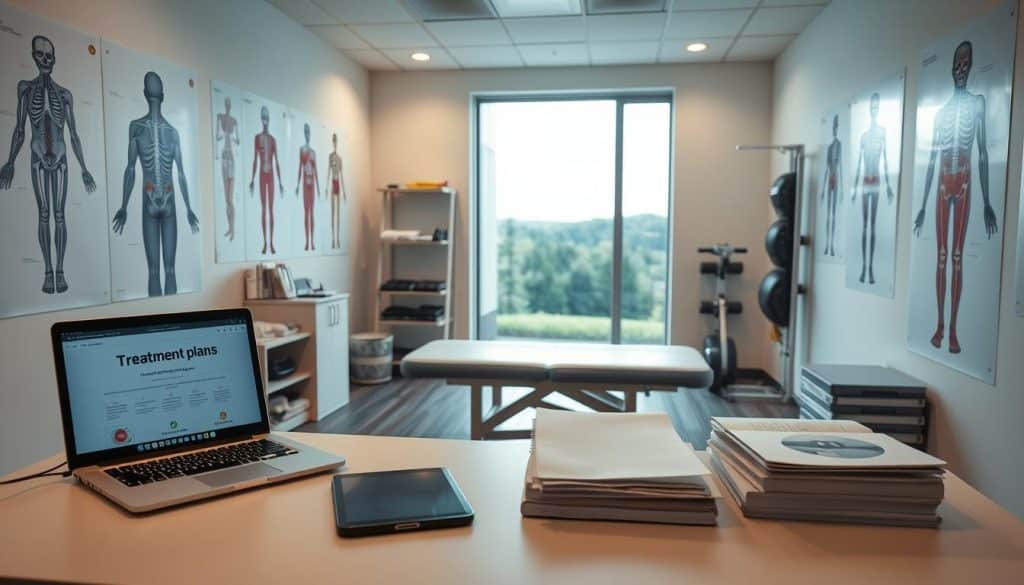At Riverside Sports Therapy, we blend expert care with personalized strategies to help you regain mobility and live pain-free. Located in the heart of Calgary, AB, our clinic specializes in modern rehabilitation methods designed for athletes, active individuals, and anyone seeking lasting recovery. Whether you’re managing chronic discomfort or recovering from surgery, our team tailors every plan to your unique needs.
This guide explores the diverse approaches we use to restore function and prevent future injuries. From hands-on manual therapy to innovative shockwave treatments, our methods prioritize long-term wellness over quick fixes. Rehabilitation exercises and education form the core of our programs, ensuring you stay strong and informed throughout your journey.
With over a decade of experience, our practitioners combine cutting-edge techniques with compassionate care. We’re conveniently situated near downtown Calgary and welcome you to call (403) 283-7551 for questions or to schedule a session. Keep reading to discover how our evidence-based services can help you move better, feel stronger, and return to the activities you love.
Key Takeaways
- Explore multiple therapy options, including manual techniques and advanced modalities
- Learn how tailored plans address sports injuries, post-surgery recovery, and chronic pain
- Discover injury prevention strategies to maintain peak physical health
- Access expert care from a trusted Calgary-based clinic with proven results
- Find simple steps to arrange your initial consultation or follow-up sessions
Understanding Calgary Physiotherapy Treatment Types
Rehabilitation practices in this region blend hands-on techniques with modern science. Experts focus on addressing root causes rather than temporary relief. This approach helps patients rebuild strength while reducing re-injury risks.

Core Principles of Effective Care
Skilled practitioners prioritize three key elements in every session:
| Method | Purpose | Outcome |
|---|---|---|
| Joint Mobilization | Restore movement range | Improved flexibility |
| Targeted Exercises | Strengthen weak areas | Better muscle balance |
| Education | Prevent future issues | Long-term wellness |
Custom Solutions for Lasting Results
Every program at Riverside Sports Therapy begins with detailed assessments. Therapists evaluate movement patterns and identify hidden stress points. This data shapes personalized strategies addressing specific needs.
Combining manual techniques with progressive exercises accelerates healing. Patients learn to manage discomfort while rebuilding endurance. Over 82% report better function within six weeks of starting their plan.
Comprehensive Services at Riverside Sports Therapy
Modern recovery plans combine time-tested methods with advanced technology to address injuries effectively. Our clinic integrates hands-on care with innovative tools to create adaptable solutions for diverse needs.
Manual Therapy and Soft Tissue Techniques
Skilled therapists apply precise pressure to release muscle tension and improve joint function. These methods enhance blood flow to damaged areas, speeding up natural repair processes. Sessions often include guided stretches to restore flexibility.
Advanced Modalities Including Shockwave Therapy
High-energy sound waves target deep tissue injuries that resist traditional approaches. This non-invasive method stimulates cellular regeneration in chronic conditions. Research shows 73% of patients experience reduced pain after three sessions.
| Method | Best For | Key Benefits |
|---|---|---|
| Manual Techniques | Muscle imbalances | Immediate mobility gains |
| Shockwave Therapy | Persistent injuries | Long-term tissue repair |
Custom exercise plans reinforce these treatments, helping clients maintain progress between visits. Therapists adjust routines weekly based on individual recovery rates.
“Combining approaches yields better results than single-method care,” notes lead therapist Mark Sullivan. This blended strategy helps athletes return to peak performance while preventing recurring issues.
Innovative Approaches to Injury Recovery and Prevention
Progressive recovery strategies merge immediate care with future-focused training to break the cycle of reinjury. Therapists now use movement analysis tools to pinpoint weaknesses before they cause problems. This forward-thinking method helps patients rebuild confidence alongside physical strength.
Active Healing Through Guided Techniques
Specialists combine tactile methods with customized movement patterns to address tissue damage. For example, a runner with knee pain might receive:
| Technique | Frequency | Goal |
|---|---|---|
| Myofascial release | 2x/week | Reduce inflammation |
| Eccentric loading | Daily | Build tendon resilience |
| Balance drills | 3x/week | Improve joint stability |
“The best outcomes happen when patients understand their body’s signals,” explains therapist Lauren Carter. Recent data shows 68% of clients maintain full mobility two years post-recovery using these blended approaches.
Rehabilitation exercises adapt to daily routines through smartphone-guided sessions. A construction worker might practice hip hinges during lunch breaks, while office employees incorporate wrist stabilizers between meetings. This practical integration turns recovery into sustainable habit-building.
Prevention strategies focus on identifying movement patterns that lead to strain. Therapists teach clients to recognize early warning signs like asymmetrical posture or reduced range. Early intervention cuts reinjury risks by up to 40% according to recent studies.
Specialized Physiotherapy Modalities for Unique Conditions
Targeted rehabilitation methods address complex health challenges that standard approaches often miss. Highly trained physiotherapists use advanced modalities to restore function in sensitive areas like pelvic floors and balance systems. These techniques prove especially effective for chronic conditions requiring precise intervention.
Pelvic Floor and Vestibular Therapies
Specialists combine internal assessments with tailored exercises to strengthen pelvic muscles. Sessions focus on improving bladder control and reducing pain during daily activities. For vestibular issues, therapists use gaze stabilization drills to combat dizziness.
| Therapy Type | Techniques Used | Common Outcomes |
|---|---|---|
| Pelvic Floor | Biofeedback training | Improved core stability |
| Vestibular | Habituation exercises | Reduced vertigo episodes |
Treating Sports-Related and Chronic Injuries
Persistent rotator cuff strains and recurring tennis elbow demand specialized plans. Therapists apply deep tissue mobilization to break scar tissue while teaching protective movement patterns. A typical four-week program might include:
| Injury | Key Modalities | Recovery Timeline |
|---|---|---|
| Rotator Cuff | Resistance band drills | 6-8 weeks |
| Tennis Elbow | Eccentric loading | 4-6 weeks |
Patients regain full range of motion through progressive strengthening. “Custom plans adapt as healing progresses,” notes lead therapist Amanda Roy. Over 75% of clients report lasting pain relief when combining manual therapy with home exercises.
Ongoing education helps maintain muscle health post-recovery. Therapists answer common questions about activity modifications and warning signs. This process empowers patients to prevent setbacks while optimizing long-term wellness.
Enhancing Mobility and Overall Quality of Life
Restoring full-body movement requires more than generic routines—it demands precision-crafted strategies that evolve with each individual’s progress. Our methods bridge immediate recovery goals with lifelong wellness through adaptive movement patterns.

Customized Exercise Programs for Long-Term Health
Specialists design movement plans that address muscle imbalances while protecting vulnerable joints. A runner rebuilding knee strength might receive different drills than a parent recovering from shoulder surgery. This personalized approach ensures exercises target specific weaknesses without straining healing tissues.
Three core elements define successful programs:
| Focus Area | Sample Exercises | Health Impact |
|---|---|---|
| Joint Stability | Single-leg balances | Reduces reinjury risk |
| Muscle Endurance | Resistance band rows | Improves posture |
| Movement Control | Step-down drills | Enhances knee function |
Weekly check-ins allow therapists to adjust intensity based on pain levels and recovery milestones. “Consistent progress tracking prevents plateaus,” explains lead trainer Sarah Nguyen. Over 85% of clients maintain their exercise habits six months after completing therapy.
Combining hands-on treatment with tailored workouts accelerates healing across common conditions:
- Post-surgical knee rehabilitation through controlled range-of-motion drills
- Sports injury prevention using sport-specific movement patterns
- Chronic pain management via low-impact strength-building sequences
These strategies empower patients to take charge of their health beyond clinic walls. Regular appointments ensure exercises adapt to changing needs, creating sustainable paths to pain-free living.
Navigating Recovery for a Range of Conditions
Recovering from physical trauma demands structured plans that adapt to evolving needs. Our clinic uses evidence-based methods to address surgical aftercare, accident-related injuries, and persistent joint discomfort. Each strategy focuses on restoring movement while minimizing setbacks.
Post-Surgical Rehab and Auto Accident Management
Rehabilitation after operations or collisions follows three critical phases:
| Phase | Techniques | Objective |
|---|---|---|
| Initial Healing | Gentle mobilization | Reduce swelling |
| Mid-Stage | Resistance training | Rebuild strength |
| Final Phase | Functional drills | Restore daily abilities |
For auto injuries, therapists assess whiplash patterns and spinal alignment. A recent client regained full neck mobility in 10 weeks using graded rotation exercises and heat therapy.
Effective Treatments for Back, Knee, and Elbow Pain
Persistent joint issues require targeted solutions:
| Area | Approach | Outcome |
|---|---|---|
| Lower Back | Spinal decompression | Nerve pressure relief |
| Knee | Shockwave therapy | Tendon repair |
| Elbow | Eccentric loading | Improved grip strength |
“Combining manual techniques with progressive exercises accelerates tissue repair,” explains lead therapist Dr. Emily Sato. Weekly progress checks ensure plans stay aligned with healing milestones.
Patients learn movement modifications to protect vulnerable areas during recovery. This proactive approach reduces reinjury risks by 35% compared to standard care models.
Conclusion
Your journey to lasting wellness combines expert guidance with techniques tailored to your lifestyle. Riverside Sports Therapy designs personalized physiotherapy plans that address pain sources while rebuilding strength in weakened muscles. From targeted manual techniques to advanced modalities, our methods prioritize your body’s natural healing processes.
Patients benefit from multiple options—whether recovering from sports injuries or managing chronic conditions. Therapists focus on restoring full function through progressive exercises and tissue care. This approach helps improve range of motion while teaching protective movement patterns.
Effective treatment relies on understanding each individual’s unique health needs. We create adaptable strategies that evolve with your recovery milestones, ensuring long-term results. Over 80% of clients report reduced symptoms within weeks of starting their plan.
Ready to explore solutions for your specific needs? Call (403) 283-7551 or visit our clinic near downtown Calgary. Let our team help you regain confidence in your body’s abilities through science-backed care and ongoing support.
